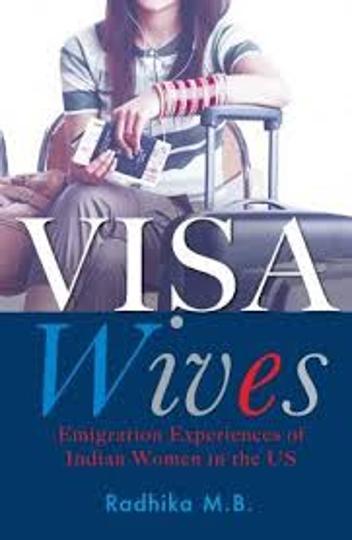A lucrative offer for the man of the house from a top US tech company, the sudden elevation in social status with parents’ eyes shining with pride, and colleagues and neighbours pretending to not be jealous… all this is far too tempting for the individual to worry about the legendary rigidity of US immigration law.
The wife, too, easily succumbs to the lure of America and the idea of the good life makes her bolt the door on her own flourishing career. Multiple conversations with herself to justify the decision follow. And just like that, the leap to being a visa wife is complete – a dependent spouse in every sense of the word in that fabled land of opportunity.
Bengaluru-based journalist Radhika MB’s Visa Wives was spurred by her own journey to the US in 2011 when her husband landed a job there. The book is a part-documentation of her own experiences and that of the several visa wives she met in the US as part of her research for a column she wrote, and later for the book.
This is a brave attempt to deconstruct what falling into the H4 visa trap – also known as the family reunion visa – entails for Indian women.
While families back home gloat over their sons’ cushy lives in America, the reality is distressing for the women who become reluctant housewives, unable to work until their green card is approved, unable even to obtain a social security number.
Most women regret their decision to relocate. Some feel the stress soon after they step into their tiny apartments, others when the thrill of talking about all-things America with their families and friends on Skype wears off. “Did they really trade their middle-class lifestyles in India for this?” – is a question that crosses their minds. “Did they really have to fulfill the familial ambitions of their men?”
Unfortunately, the American dream is planted early in the subcontinent with children being groomed to study in “the States”, girls being eagerly married off to H1B visa holders, often in lieu of a handsome dowry.
Case by case, Radhika details the trauma that these women experience, the pain that no one talks about, baring the farce that most of their lives are. At one end of the spectrum are women who are lonely and miss their financial independence; and at the other end are those who have slipped into depression. She details the case of a woman who had to be admitted to a mental health facility soon after her arrival.
Besides there are plenty of cases of marital abuse and of relationships under strain.
Additionally, there is work-related politics at the husband’s office to think about, the nagging feeling of him bearing the brunt of the next downsizing, the abrupt ending of his contract and the eventual “disgraceful” return to India.
Radhika’s husband had to leave for the US at a ridiculously short notice of four days, after an almost six-month wait. While she experienced mixed emotions on news of his flying off, her father-in-law’s chest swelled with pride. “‘He is heading to the US,’ his dad repeated to friend after friend as my husband went red with embarrassment.”
Forty days later, Radhika herself boarded a flight to the US and became a visa wife. “Little did I know, much like thousands of women who immigrate to the US, what the move to America really meant.”
According to a report in the Guardian, of the 125,000 H4 dependent visas granted in 2015, 80 per cent were issued to Indian passport holders.
The earliest recorded Indian immigrant landed on America’s shores in 1790, the author writes. They are believed to have settled down to trade in Indian goods and spices and married local American women of African origin.
There is mention of Indian women who came as wives as early as 1910. Anti-Asian sentiment was so strong then that when the fourth Indian woman arrived, a newspaper headline read: “Hindu Women Next Swarm to California”. By 1940, families of Indian men were allowed into the country. Indian women mass-migrated to join their husbands in the 1960s and the trend has continued.
Radhika’s focus is on the shock that Indian women go through when they land, their inability to fill the gap between the imagined and the real. Some get depressed at the lack of a puja room, others at the overwhelming silence on the streets.
Fortunately, not all stories are unhappy. Many adjust well and are happy to be in the land of opportunity.
Radhika’s book, which is rooted in reality, will surely come in handy for women headed to the US. She records in detail every stage that these women encounter to relocate – such as how to apply for the visa, how to face the interview, how to interact with officers at US immigration.
However, it is easy to get lost in the mesh of names. The readers may have to occasionally flip pages backwards to keep track of the case studies and match names. They may wonder if Kripakar Nath’s wife was the one who liked dogs and adopted one? Or was she the one who arrived on an H1B visa?
There is plenty of trivia which a relocation to any village or town within India or abroad entails. “You suddenly must discard your books, kitchen utensils, tools and relics that are part of your daily existence…”
The mundane and the obvious take up too many pages: how is shopping in an American mall different from India. Or how closets in America are different from the ones in India; how American bathrooms have tissue rolls; how the utility of the fridge in an American home is much more than in an Indian household; how vacuum cleaners are preferred over brooms….
There are other bits such as parents worrying about children’s safety given America’s gun culture and the difference between Indian and Western ideas of parenting and western cultures, which do not quite gel with the primary theme of the book.
Nevertheless, this is a book full of practical advice for assimilating into the American culture, and should be a recommended read for all women intending to make that move. It will make the relocation less distressing and, most importantly, it will take the sheen off that great land of opportunity.






Leave a reply